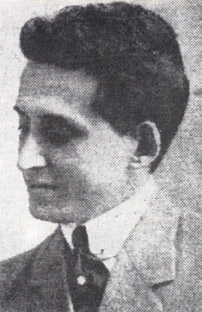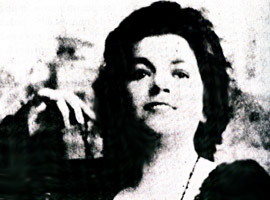
Panart was one of the first and most successful independent record labels in Cuba, founded in 1944 by engineer Ramón Sabat. In 1961, its studios were seized by Fidel Castro's communist regime and the label was nationalized, becoming "Panart Nacionalizada", which shortly after was absorbed by EGREM.
Guillermo Portabales was a Cuban singer-songwriter and guitarist who popularized the guajira style of Cuban music from the 1930s through the 1960s. His languid, melancholy, intensely lyrical guajiras and his elegant, stylish singing made him popular throughout Latin America, where he is still revered.
Guajira is a music genre derived from the punto cubano. According to some specialists, the punto cubano was known in Spain since the 18th century, where it was called "punto de La Habana", and by the second half of the 19th century it was adopted by the incipient Spanish Flamenco style, which included it within its "palos" with the name of guajira. Guajira was utilized by Spanish Zarzuela composers, such as Ruperto Chapí, who included it in his well known play "La Revoltosa", from 1897. Two years later, in 1899, the Cuban composer Jorge Anckermann inaugurated a new genre with his song "El arroyo que murmura", the first Cuban guajira. This song became a model that was adopted by many other Cuban composers at a later time, and was frequently included in the Cuban Zarzuela and vernacular theater.
Son cubano is a genre of music and dance that originated in the highlands of eastern Cuba during the late 19th century. It is a syncretic genre that blends elements of Spanish and African origin. Among its fundamental Hispanic components are the vocal style, lyrical metre and the primacy of the tres, derived from the Spanish guitar. On the other hand, its characteristic clave rhythm, call and response structure and percussion section are all rooted in traditions of Bantu origin.
A descarga is an improvised jam session consisting of variations on Cuban music themes, primarily son montuno, but also guajira, bolero, guaracha and rumba. The genre is strongly influenced by jazz and it was developed in Havana during the 1950s. Important figures in the emergence of the genre were Cachao, Julio Gutiérrez, Bebo Valdés, Peruchín and Niño Rivera in Cuba, and Tito Puente, Machito and Mario Bauzá in New York. Originally, descargas were promoted by record companies such as Panart, Maype and Gema under the label Cuban jam sessions. From the 1960s, the descarga format was usually adapted by large salsa ensembles, most notably the Fania All-Stars.
"Quiéreme mucho" is a criolla-bolero composed in 1911 by Gonzalo Roig with lyrics by Ramón Gollury and Agustín Rodríguez. The song was inspired by Roig's wife, Blanca Becerra, and premiered in Havana in 1911 without much success. In 1917, it was included in the sainete El servicio militar obligatorio and performed by Becerra and Rafael Llorens to critical acclaim. Roig published and sold the rights to the song in 1921, and the first recording was made in the United States by singer Tito Schipa in 1923. The English version, "Yours", was published in 1931 in the United States. It featured lyrics in English written by Albert Gamse and Jack Sherr. Both versions have been extensively recorded and arranged by different musicians, becoming Latin music standards.

Benito Antonio Fernández Ortiz, better known as Ñico Saquito, was a Cuban trova songwriter, guitarist and singer. He is widely considered the most prolific and successful composer of guarachas, most of which he wrote during his stint as a member of Los Guaracheros de Oriente. Among his most enduring compositions are "Cuidadito compay gallo", "María Cristina", "Adiós compay gato", "Al vaivén de mi carreta", "Camina como Chencha" and "Amarrao compé".
Rosendo Ruiz Suárez was a Cuban singer, guitarist and composer, considered one of the founders of the trova. He wrote over 200 songs in a variety of styles ranging from canción and bolero to guajira and bambuco. Although he was a popular performer, founding several successful groups, he made very few recordings. He lived for almost a century, having a great influence on the music of his country.
Early Cuban bands played popular music for dances and theatres during the period 1780–1930. During this period Cuban music became creolized, and its European and African origins gradually changed to become genuinely Cuban. Instrumentation and music continually developed during this period. The information listed here is in date order, and comes from whatever records survive to the present day.

The Sexteto Habanero was a Cuban son sextet founded in 1920 in Havana. It played an important part in the early history of the genre, contributing to its popularization all around Cuba. In 1927, the band incorporated a cornet player becoming the Septeto Habanero. Although most original members left in the 1930s, the band has continued to perform and record with different line-ups. Their last album was released in 2010 for their 90th anniversary.
Cuban musical theatre has its own distinctive style and history. From the 18th century to modern times, popular theatrical performances included music and often dance as well. Many composers and musicians had their careers launched in the theatres, and many compositions got their first airing on the stage. In addition to staging some European operas and operettas, Cuban composers gradually developed ideas which better suited their creole audience. Characters on stages began to include elements from Cuban life, and the music began to reflect a fusion between African and European contributions.

Adolfo Columbo was a leading singer in the Alhambra Theatre in Havana, and also an actor and a leading personality in the theatre. Colombo was the most recorded artist in Cuba up to 1925: records show he recorded about 350 numbers between 1906 and 1917.

Chalía Herrera, born Rosalía Gertrudis de la Concepción Díaz de Herrera y de Fonseca, was a Cuban soprano. She had the distinction of being the first Cuban musical artist to be recorded. She recorded, outside Cuba, numbers from the zarzuela Cádiz in 1898 on unnumbered Bettini cylinders. Much of her career was spent in Cuba, but she also sang in Mexico City, New York City, Milan, Caracas, Madrid and Barcelona.

Antonio Arcaño Betancourt was a Cuban flautist, bandleader and founder of Arcaño y sus Maravillas, one of Cuba's most successful charangas. He retired from playing in 1945, but continued as director of the group until its dissolution in 1958. Despite his early retirement due to health problems, he is considered one of the most influential flautists in Cuba.

Isaac Oviedo was a Cuban tres player, singer and songwriter. He was the founder and leader of the Septeto Matancero for over 50 years, and the author of many famous sones such as "Engancha carretero". Throughout his long career Oviedo only recorded a handful of sessions, mostly for American record labels. He has been called "one of the greatest Cuban tres players" by other musicians such as Efraín Ríos and Pancho Amat. According to the latter, Oviedo was the pioneering and most influential tresero of the septeto format. His technical innovations include the alzapúa thumb stroke and the use of the pinky finger.
Puchito Records was Cuba's second independent record label. It was founded in 1954 during the mambo and cha-cha-chá explosion. Many of its recordings, produced by its founder Jesús Gorís, became instant hits.
Terceto Nano was a Cuban trova trio founded by singer/songwriter Román León, nicknamed "Nano", and active during the 1910s. It is noted for being one of the earliest groups in the transition from the traditional vocal duet with guitar accompaniment to the vocal trio with one or two guitars. Between 1911 and 1916, the trio recorded 24 songs in Havana for Victor. Such recordings are among the first made a Cuban terceto, and among the first recordings of punto guajiro made by actual trovadores.
Juana Coralia López Valdés was a Cuban pianist, bandleader and composer. Between 1940 and 1956 she directed her own charanga danzonera, being the first woman to direct any such orchestra in Cuba. During her career she composed many popular danzones such as "Llegó Manolo", "El bajo que come chivo", "Los jóvenes del agua fria" and the famous "Isora Club", which became a standard in the Latin music repertoire.

"Suavecito" is a Cuban son written by Ignacio Piñeiro and first recorded by his Septeto Nacional in 1929. It is a standard of the son repertoire and one of the biggest hits by the Septeto Nacional. It has been covered by numerous artists including Cuarteto Machín, Celia Cruz, Orquesta Aragón and Sierra Maestra.
"Juventud del Pueblo Nuevo", or simply "Pueblo Nuevo", is a danzón composed by Cuban bassist Israel López "Cachao". It is one of his many compositions dedicated to a Cuban venue where he frequently played as part of the charanga Arcaño y sus Maravillas. It has become a standard of the genre, being regularly performed by danzón orchestras over the years.








